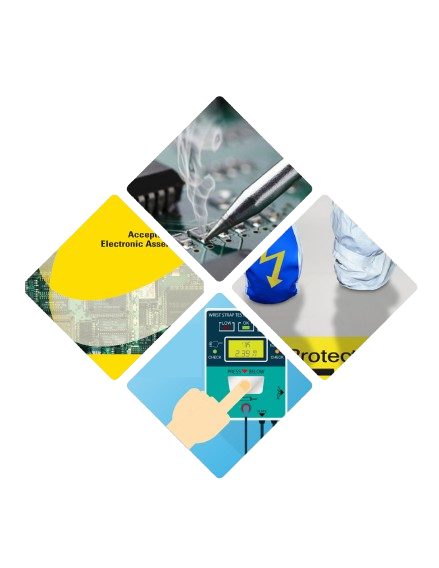ESD PROTECTION
Training
- operator -
- technician -
- coordinator -
- auditor -

TRAINING
OBJECTIVE
All people who get in contact with ESD sensitive areas will gain appropriate knowledge for the proper use of local ESD areas, protective equipment, to control the proper use. Students should gain FULL proficiency in ESD regulations.
TARGET GROUP
- Operators
- Technicians
- Engineering
- Quality
- Middle Management
- Senior Management
- Auditors
- Any other people who get
in contact with ESD
sensitive areas
COMPETENCIES
ACCQUIRED
- Method knowledge
- Analysis
- Measure
- Decision competence
- Document knowledge
- Action
TOPIC
Module 1:
● Introduction. (Required! Lv from 2 upwards)
● What is ESD?, Historical Overview, Basic Concepts of ESD
● Ways in which ESD is generated (static electricity and its nature),
● Damage caused by ESD and the basics of protection against it.
Module 2:
● Types of discharges (optional)
● Varieties of different discharges and their characteristics.
Module 3:
● Standards. (Required! Lv from 2 upwards)
● Standardization
● IEC and ANSI standards
● Common points and differences
● Compliance with standards
● Standard processing
● Standard consequences
● Things to do when introducing/transforming/changing and conflicting
● Identification of ESD sensitive substances
Module 4:
● Standards. (Additional standards) (option)
● Other standards
● Specific standards
● Difference in approach
Module 5:
● Basic standard concepts. (Required! Lv from 2 upwards)
● Abbreviations and technical terms in standards and practice
Module 6:
● EOS (Required! Lv from 2 upwards)
● The relationship between electrical overload and ESDprotection
Module 7:
● Sensitivity. (Required! Lv from 2 upwards)
● Identification of ESD sensitive substances
● Introduction of ESD models (HBM, CDM, MM…)
● Introduction to ESD events
Module 8:
● ESD protection measurements. (Required! Lv from 2 upwards)
● Practical application of instruments and measurement methods
● Error analysis
● Recording, development, updating and follow-up of
documentation background
Module 9:
● EPA. (Required! Lv from 2 upwards)
● Ways to Plan and Build the EPA
● ESD protection procedures and tools used
● Correct use of the required protective equipment (inspection, self-testing)
● Authorized and unlicensed devices, materials
● Correct use of applied test equipment
Module 10:
● ESD protection products and regulations. (Lv 3 upwards)
● Definition of the ESD control program, technology and practice of EPA planning and construction
● Selection, use, training, measurement and review of ESD protection products
Module 11:
● Ionization. (option)
● The relationship between ionization and ESD protection
● Principles of operation of ionizers
● Varieties of ionizers
● Structure of ionizers
● Correct and incorrect application of ionizers
Module 12:
● ESD protection and cleanroom. (optional)
● The relationship between cleanroom and ESD protection
● Cleanroom standards
● Correct and incorrect areas of application
Module 13:
● ESD protection and sensitivity to moisture (optional)
● The relationship between moisture sensitivity and
ESD protection
● Moisture sensitivity standards
● Correct and incorrect areas of application
Module 14:
● Protection against ESD at component level (option)
● Means of protection options at the component level
● Limitations and options for protection
Module 15:
● ESD protection audit (option) (+2days)
● Internal, customer and supplier audits
● Completing this module provides a registered internal auditor certificate.
● Those who already have an auditor’s degree receive further training in the subject of “ESD audit”.
Module 19:
● ESD protection and Work safety (optional)
Module 20:
● ESD control Program Plan (optional)
● IEC and ANSI version also available
Module 21-56:
● Customized company trainings
Module 57:
● EM Eye, ESD event detector (optional)
● EM, ESD, wave measuring basics
Module 58:
● Train to trainers (optional for inner trainers)
● University level trainer technics
Module 59:
● Summary (Required! Lv from 2 upwards)
● Summary and organization of what you have learned
INSTRUCTIONS
End of the training: Written exam, practical exam (or just accountability)
Participants: Min: 1 pers, Max: 12 pers
Training length: 1, 2 or 3 days
Training support is provided by the instructor during the training, but there is an opportunity to purchase it.
PCBs, tools and materials needed for practice are provided by the instructor,
but it is also possible to use your own pcbs / tools / materials.

Contact
Phone:
RO +40 725 378 479
HU +3630 381 1185
E-mail: trainings@mastertextil.ro
Location: Oradea, str. Lapusului nr. 6, ROMANIA
Useful links

©2023. All rights reserved.
